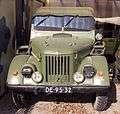GAZ-69
The GAZ-69 is a four-wheel drive light truck, produced by GAZ (ГАЗ, or Gorkovsky Avtomobilnyi Zavod, Gorky Automobile Factory) between 1953 and 1956 and then by UAZ, in 1956–1972, though all of these vehicles were known as GAZ-69s.[1]
| GAZ-69 | |
|---|---|
| Overview | |
| Manufacturer | |
| Also called | Kaengsaeng 68 Sungri 4.10 Sungri 4.25 UAZ-69 |
| Production | 1953-1972 (in Romania - until 1975) |
| Assembly | Gorky, Ulyanovsk (USSR), Câmpulung (Romania) |
| Body and chassis | |
| Class | Light truck |
| Body style | 2-door cargo, 4-door field car |
| Layout | F4 layout |
| Related | IMS-57, M59, ARO M461 |
| Powertrain | |
| Engine | 2.1L GAZ-69 I4 |
| Transmission | 3-speed manual |
| Dimensions | |
| Wheelbase | 2,300 mm (91 in) |
| Length | 3,850 mm (152 in) |
| Width | 1,750 mm (69 in) |
| Height | 1,950 mm (77 in) |
| Curb weight | 1,535 kg (3,384 lb) |
| Chronology | |
| Predecessor | |
| Successor | UAZ-469 |


Development and production
The GAZ-69 was created by the team of chief designer Grigoriy Vasserman as a replacement for the GAZ-67B that would have lower fuel consumption than its predecessor and use the same 55 hp (41 kW; 56 PS) 2.1 L (130 cu in) inline four and three-speed transmission as the GAZ-M20 Pobeda. The development process started in 1946 and the first prototypes known under the name "Truzhenik" (Toiler) were built in 1947. After extensive on-road testing, the new off-road vehicle went into production on August 25, 1953.[2] Over 600,000 GAZ-69s had been built by the end of production in the USSR in 1972. A similar vehicle based upon the GAZ-69's design was produced by ARO in Romania until 1975, first as the IMS-57, then as the IMS M59, and later modernized as the ARO M461.[3] GAZ-69s were standard military jeeps of the Eastern Bloc and client states.
Design
The standard GAZ-69 was able to reach 56 mph (90 km/h),[4] but its more powered versions, with 2400 cc (derived from the basic 2100 cc) 65 h.p. engines and the same three-speed gearbox, could reach 100 km/h (62 mph). They were known as the GAZ-69M, or GAZ-69AM for the four-door version.[5]
It featured two fuel tanks, one of 47 litres (12 US gal; 10 imp gal) under the floor, one of 28 litres (7 US gal; 6 imp gal) beneath the passenger's seat.[1] All civilian models also had to meet Army requirements, in case of wartime requisitioning. (This is also why a hardtop version was not available until 1993)[6] The basic variant GAZ-69 has a pair of doors and usually has standard canvas top and upper sides; there are two seats in front and two folding benches for three passengers each on sides. The further variant GAZ-69A (UAZ-69A) has four doors, folding canvas top and two rows of seats.
It was used as the basis for the rear-wheel drive van GAZ-19 that was built in 1955 but didn't pass the prototype stage. The off-road van and light truck UAZ-450 and the newer UAZ-469 also traced their origins to the GAZ-69.[5]
Military use
The GAZ-69 had been the basic light off-road vehicle of the Soviet Army, replacing GAZ-67s and Willys Jeeps, before the army adopted the UAZ-469.[5] It was also used as the basis for the 2P26 tank destroyer, as well as for the GAZ 46 MAV, a light 4x4 amphibious vehicle inspired by the Ford GPA 'Seep'.[5]
Gallery

 A retired GAZ-69 in the Fort aan den Hoek van Holland in Hoek van Holland, Netherlands
A retired GAZ-69 in the Fort aan den Hoek van Holland in Hoek van Holland, Netherlands A GAZ-69 of the Hungarian Army
A GAZ-69 of the Hungarian Army UAZ-69M, front view
UAZ-69M, front view.jpg) UAZ-69M
UAZ-69M GAZ-69, interior
GAZ-69, interior Grigory Sherbak in a GAZ-69 during a parade on Victory Square in Kishinev (1965).
Grigory Sherbak in a GAZ-69 during a parade on Victory Square in Kishinev (1965).
References
- Thompson, Andy. Cars of the Soviet Union (Haynes Publishing, Somerset, UK, 2008), p. 70.
- "The history of the development of the GAZ-69" (in Russian). www.off-road-drive.ru.
- IMS M461, "Avtolegendy SSSR i Socstran" No. 168, DeAgostini 2015, ISSN 2071-095X (in Russian), p.3-6
- Thompson, p. 176.
- Ware, Pat. The World Encyclopedia of Military Vehicles (Lorenz Books, 2010), p. 177.
- Thompson, p. 176
External links
| Wikimedia Commons has media related to GAZ-69. |